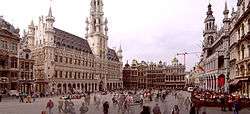Metropolitan areas in Belgium
National statistics differ between five Metropolitan areas in Belgium.[1] These five metropolitan areas (Dutch: Agglomeratie, French: Agglomération) are also covered by Eurostat statistics as separate Larger Urban Zones (LUZ).
Metropolitan areas
| Rank | metropolitan area | region | core city population |
metro population |
LUZ population |
LUZ area |
LUZ pop. density |
|---|---|---|---|---|---|---|---|
| 1 | Brussels-Capital Region |
1,154,635 (2013) | 1,789,447 (2006) | 1,800,663 (2004)[2] | 1,614 km² | 1116 inhabitants/km² | |
| 2 | Antwerp metropolitan area |
507,911 (2013) | 940,671 (2006) | 915,258 (2004)[3] | 941 km² | 972 inhabitants/km² | |
| 3 | Liège metropolitan area |
195,931 (2013) | 633,934 (2006) | 626,357 (2004)[4] | 1,055 km² | 594 inhabitants/km² | |
| 4 | Ghent metropolitan area |
248,813 (2013) | 416,493 (2006) | 399,741 (2004)[5] | 537 km² | 744 inhabitants/km² | |
| 5 | Charleroi metropolitan area |
203,753 (2013) | 403,868 (2006) | 386,060 (2004)[6] | 615 km² | 628 inhabitants/km² |
See also
References
- ↑ De Belgische Stadsgewesten 2001, Sarah Luyten, Etienne Van Hecke, Instituut voor Sociale en Economische Geografie, K. U.Leuven
- ↑ Urbanaudit.org
- ↑ Urbanaudit.org
- ↑ Urbanaudit.org
- ↑ Urbanaudit.org
- ↑ Urbanaudit.org
External links
This article is issued from Wikipedia - version of the 6/15/2015. The text is available under the Creative Commons Attribution/Share Alike but additional terms may apply for the media files.